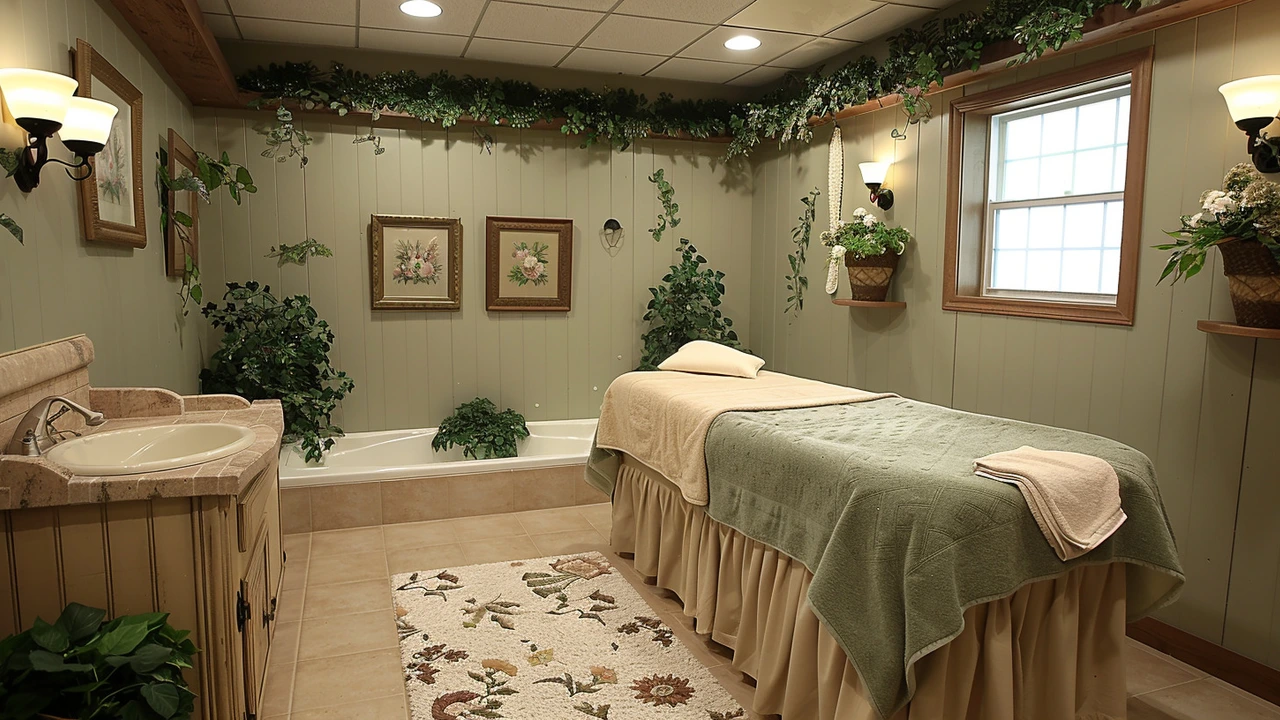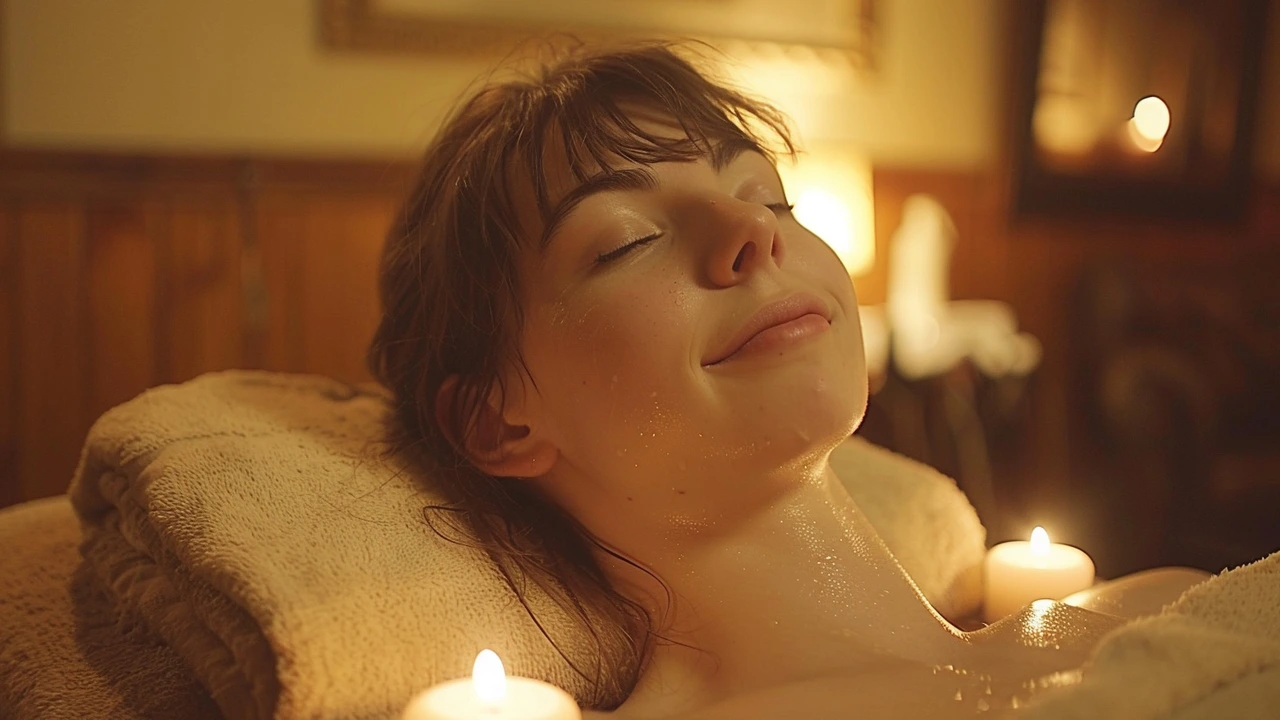Unlock Better Health with Craniosacral Therapy: Balance and Wellness Guide
 Jun, 11 2024
Jun, 11 2024
Craniosacral Therapy (CST) may not be something you hear about every day, yet it's a powerful practice worth understanding. It's a gentle therapy, often performed by osteopaths, chiropractors, or massage therapists, where light touch is applied to assess and enhance the craniosacral system.
The core idea is to help the body heal itself. The craniosacral system extends from the skull, down the spine to the sacrum. It's wrapped in membranes and filled with cerebrospinal fluid that cushions the brain and spinal cord. By freeing this system from restrictions, practitioners believe they can enhance overall health and well-being.
The process is quite simple and relaxing. As you lie on a massage table, the practitioner uses their hands to feel for changes in the craniosacral rhythm and apply gentle manipulations. This can result in a release of tension, easing both physical and emotional stress.
This therapy has been reported to help with numerous conditions, from chronic pain and migraines to stress and even postural problems. It's worth considering if you’re exploring alternative health options that blend physical and mental healing.
- Understanding Craniosacral Therapy
- Health Benefits
- What to Expect During a Session
- Conditions it Can Help
- Tips for Getting the Most Out of Therapy
Understanding Craniosacral Therapy
Craniosacral Therapy, often abbreviated as CST, is a holistic healing practice that dates back to the early 20th century. It was developed by Dr. William Sutherland, an osteopathic physician who discovered that the bones of the skull were not immobile as previously believed. He found they exhibited subtle movements, which influenced the body's health and well-being. This discovery led to the birth of CST, focusing on the craniosacral system, which includes the membranes and fluid that surround the brain and spinal cord.
The essence of CST lies in its gentle, minimalistic approach. Practitioners use light touch, generally no more than the weight of a nickel, to palpate and manipulate the craniosacral system. This light touch is employed to release tensions deep in the body and enhance the central nervous system's performance. The treatment can facilitate a deep sense of relaxation and improve overall function and health.
During a typical session, the client remains fully clothed and lies comfortably on a massage table. The practitioner, using a series of techniques, assesses the craniosacral rhythm, which is the gentle ebb and flow of the cerebrospinal fluid within the craniosacral system. These techniques are non-invasive and are often described as soothing and meditative.
One of the unique aspects of CST is its holistic nature. It does not simply focus on symptoms but seeks to identify and address the root causes of discomfort or dysfunction. By enhancing the body's natural healing processes, CST may help alleviate a wide range of conditions including chronic pain, migraines, and stress-related disorders. It supports the body in its efforts to self-correct and maintain balance.
The science backing CST emphasizes its connection to the nervous system. Since the craniosacral system houses the brain and spinal cord, any disturbances or restrictions in its fluid or membranes can potentially affect the entire body. CST aims to ensure the smooth flow of cerebrospinal fluid, which can lead to improved neural and physiological function. According to Dr. John Upledger, a leading figure in CST, "The craniosacral system is responsible for maintaining the environment in which the central nervous system functions, and it has a significant impact on overall health and resistance to disease."
An intriguing part of CST is the listening skill of the practitioners. They are trained to tune into the body's subtle rhythms and movements, which can give insights into areas of restriction or blockages. By applying light pressure, they help release these tensions, promoting improved health. Many clients report feeling a gentle pulsing sensation, tingling, or warmth during the sessions, indicative of the body’s responses to the therapy.
For those new to CST, it might be helpful to know that the therapy is widely practiced and respected in many parts of the world. It’s often included in the repertoire of osteopaths, chiropractors, and physical therapists. Each practitioner may bring their unique background and expertise to the practice, enriching the potential benefits of the treatment. The evidence supporting CST is growing, and while it might not yet be mainstream, its efficacy is becoming more recognized across various healthcare fields.
Health Benefits
The beauty of Craniosacral Therapy is in its broad scope of potential benefits for both the body and mind. It's known for its gentle touch, yet the impact can be quite profound. One of the primary benefits is pain relief. People suffering from chronic pain conditions, such as fibromyalgia or tension headaches, may find significant relief through regular sessions. By releasing restrictions in the craniosacral system, tension across the body diminishes.
Stress and anxiety reduction is another key benefit. In today's fast-paced world, finding effective ways to manage stress is crucial. The therapy's light touch and mindful techniques can promote a deep state of relaxation. This in turn helps to balance the autonomic nervous system, shifting it away from the 'fight or flight' response to a more restful state.
According to John Upledger, the founder of Craniosacral Therapy, “the therapy helps the body's natural healing processes dissipate the negative effects of stress on the central nervous system.”
Migraines and headaches are pesky problems for many, but Craniosacral Therapy can help to alleviate this as well. Through subtle adjustments, practitioners can address restrictions in the tissues surrounding the brain and spinal cord, which often lead to intense headaches. Regular sessions often result in fewer migraines and less intense headaches.
Sleep improvement is another commonly reported benefit. Poor sleep can be due to many factors, but some of it is linked to the nervous system and musculoskeletal imbalances. By aligning the craniosacral rhythms and releasing tensions, many find they sleep more soundly and wake up feeling more refreshed.
Postural improvement is another fascinating benefit. Poor posture can lead to a host of other health problems, including back pain, neck pain, and even digestive issues. Craniosacral Therapy can help in realigning the body, promoting better posture and alleviating these issues. The therapy's focus on the spine and skull can make significant changes in how one holds their body.
This therapy is also particularly beneficial for infants and children. Conditions like colic, sleep disturbances, and developmental delays can be addressed with Craniosacral adjustments. Parents often report their children are more settled and exhibit fewer symptoms after sessions.
Digestive health can also benefit from Craniosacral Therapy. The nervous system plays a huge role in digestion, and by promoting a balanced and relaxed state, digestive processes can improve. Issues such as bloating, constipation, and IBS may see improvement through regular sessions.
| Condition | Reported Benefit |
|---|---|
| Chronic Pain | Reduction in pain and increased mobility |
| Stress and Anxiety | Lower stress levels, increased relaxation |
| Migraines | Fewer occurrences, less intensity |
| Sleep Disorders | Improved sleep quality |
| Postural Issues | Better alignment and reduced discomfort |
| Digestive Problems | Improved digestion, reduced symptoms |

What to Expect During a Session
Embarking on your first Craniosacral Therapy (CST) session can be both exciting and a bit mysterious. This gentle form of bodywork focuses on the craniosacral system, comprising the membranes and fluid that surround and protect the brain and spinal cord. Understanding what to expect can help put your mind at ease and maximize the benefits.
When you walk into a session, the atmosphere is typically tranquil. Soft lighting, soothing music, and perhaps aromatic essential oils set the scene. You stay fully clothed, often lying on a comfortable massage table. The therapist starts by evaluating your body’s rhythms and palpating areas around your skull, spine, and sacrum.
The therapist’s touch is extremely light, more like a gentle pressure or hold. This is not a massage; don’t expect kneading or deep muscle work. Rather, the practitioner’s hands hover or rest softly, listening to the body's natural craniosacral rhythm. Some describe the experience as deeply relaxing, occasionally drifting into a state of restful awareness.
As your session progresses, the therapist might focus on specific areas showing restrictions or imbalances in the craniosacral flow. Subtle manipulations or holds aim to release these restrictions. The process is delicate and non-invasive. At times, you might feel a gentle pulsing or a sense of warmth where the therapist's hands rest. This is often a sign of the body's response to the therapy.
It's essential to communicate openly with your therapist. If at any point you feel uncomfortable or experience discomfort, share that immediately. Effective therapy thrives on trust and collaboration, much like other forms of holistic treatments.
“Craniosacral Therapy supports the body's natural capacity for self-regulation, healing, and health,” says Dr. John Upledger, an osteopathic physician and a pioneering figure in CST.
After the session, you might feel a profound sense of relaxation or even fatigue. Some people experience immediate relief from symptoms, while for others, the benefits unfold over several hours or days. It’s common to feel a heightened sense of clarity or emotional release too.
To maximize the benefits, drink plenty of water and avoid strenuous activities immediately after your session. Journaling any changes or feelings can also be handy. Noting patterns or shifts can give you a deeper insight into how CST is aiding your body.
Multiple sessions might be recommended based on your specific conditions or goals. The therapist will work with you to determine an appropriate frequency. Regular follow-ups can deepen the impacts, gradually leading to more significant and lasting changes.
Conditions it Can Help
Craniosacral Therapy is increasingly recognized for its potential in aiding various health conditions. One notable area is chronic pain. Chronic pain can be debilitating and affect one's quality of life. The gentle touch used in Craniosacral Therapy can help release tightness and tension in the tissues surrounding the central nervous system. This release can alleviate pain, promoting better physical function and mental peace.
This therapy has shown promise in addressing migraines and headaches as well. Tension and compression can contribute heavily to headaches. By working on the craniosacral system, practitioners aim to reduce these contributing factors. Many individuals report a decrease in the frequency and intensity of their headaches after several sessions.
Another area where Craniosacral Therapy can be beneficial is stress and anxiety. The body and mind are intricately connected, and physical tension can often contribute to mental stress. Craniosacral Therapy helps in reducing this physical tension, thereby easing anxiety and stress levels. It provides a calming effect that can improve emotional well-being.
Patients dealing with postural problems and musculoskeletal issues may find relief through CST as well. The therapy's gentle manipulations can help correct imbalances in the body's structure. Over time, improved posture and alignment can lead to reduced pain and better overall body mechanics.
Children also benefit from this therapy. Conditions like colic, ADHD, and autism spectrum disorders can show improvement through Craniosacral Therapy. The non-invasive and gentle nature of this approach makes it suitable for young children, offering them a safe way to address various developmental and health issues.
Lastly, CST can support patients dealing with trauma and PTSD. By facilitating a state of deep relaxation, it can help the body process and release traumatic memories. This can be a crucial part of a holistic approach to trauma recovery.
According to a study published in the Journal of Alternative and Complementary Medicine, "Craniosacral Therapy has shown significant potential as a complementary treatment for various conditions, providing benefits that go beyond symptom relief to enhance overall well-being."
With such diverse applications, it's clear that Craniosacral Therapy offers a gentle yet effective approach for those seeking alternative health solutions. Whether dealing with chronic conditions or looking to boost general wellness, CST can be a valuable tool in the holistic health toolbox.

Tips for Getting the Most Out of Therapy
When embarking on your journey with Craniosacral Therapy, there are several key strategies to ensure you maximize the benefits of each session. First, it's important to approach the experience with an open mind. This isn't your typical massage or chiropractic adjustment and may feel subtle at first, but don't be fooled by the gentleness of the technique—its effects can be profound.
One of the most important things you can do is communicate openly with your practitioner. Share your health history, any specific issues you're dealing with, and what you're hoping to achieve from the therapy. This information helps the practitioner tailor the session to your needs. Before the session starts, discuss any anxieties or questions you might have, which can help you relax and be more receptive to the treatment.
Another tip is to pay attention to your body's feedback. After a session, you may notice shifts both immediately and over time. These could be physical, like reduced pain or tension, or emotional, such as an increased sense of calm or even an emotional release. Keeping a journal of these changes can be useful for both you and your therapist to track progress and make any necessary adjustments in your approach.
Hydration is also key. Drinking plenty of water before and after your session can help support your body’s natural detoxification processes. When your muscles and tissues are well-hydrated, they are more likely to respond effectively to the treatment. Combine this with a balanced diet for the best results, as your overall health can influence the effectiveness of CST.
Regular sessions often yield better results. While some people may experience significant improvements after just one or two sessions, others may find a long-term commitment is more effective. Many practitioners suggest a series of sessions over several weeks to truly get the most out of Craniosacral Therapy.
Try to avoid scheduling anything stressful immediately after a therapy session. This allows your body and mind to fully integrate the benefits of the treatment without being interrupted by the pressures of everyday activities. Instead, plan for some quiet time where you can relax and unwind.
"The rhythm of the craniosacral system is fundamental to the functioning of our nervous system," says Dr. John Upledger, a pioneer in Craniosacral Therapy. "Balancing this rhythm can help relieve a wide variety of health problems and promote overall wellness."
Finally, consider combining Craniosacral Therapy with other holistic practices, such as yoga, meditation, or mindfulness. These activities can complement CST and enhance your overall sense of well-being, making it easier for your body to maintain the positive changes achieved during therapy.
